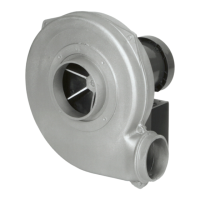1. Rotating parts including shaft and V-belt drives must
be properly guarded to prevent personal injury.
2. Electrical wiring must be accomplished by a qualified
electrician in accordance with all applicable codes.
3. Care should be taken:
• Not to run fan above its safe speed
(See Performance Tables in Sales Catalog or
call CF sales office).
• Not to operate in excessive temperatures
(See limitations in Sales Catalog or call CF
sales office).
• Not to operate in dangerous environments.
• Read all instructions carefully.
Receiving Inspection
When unit is received, inspect immediately for damaged
or missing parts. Even though all units are carefully
inspected and prepared for shipment at the factory,
rough handling en route may cause concealed damage
or cause nuts, set screws, bolts or locking collars to
work loose. Be certain all fasteners are tightened
securely. Rotate wheel by hand to verify that it rotates
freely and that there are no obstructions.
Inspect all shipments carefully for damage. The
receiver must note any damage on the carrier’s bill
of lading and file a claim immediately with the
freight company in case of damage. Keep a record of
all equipment received, including inspection details and
date of receipt because of the possibility of partial
shipments.
Handle your equipment with care. Some fans are
provided with lifting lugs or holes for easy handling.
Others must be handled using nylon straps or well-
padded chains and cables which protect the fan’s
coating and housing. Spreader bars should be used
when lifting large parts.
Centrifugal fans are best lifted using one strap under the
fan’s scroll and another strap around the bearing base.
DO NOT LIFT CENTRIFUGAL FANS BY THE FAN
SHAFT, WHEEL, FLANGES, INLET SUPPORT OR
MOTOR EYE BOLT.
Foundations
Fan foundation must be flat, level and rigid. Where
foundation is not completely flat, shims must be placed
under fan support at each anchor bolt as required.
Bolting fan to an uneven foundation distorts alignment
and causes vibration.
Structural steel foundations should be heavily cross-
braced for load support.
2
I. GENERAL SAFETY NOTES
II. RECEIVING
III. HANDLING
IV. GENERAL INSTALLATION INSTRUCTIONS
NOTE:
If wheel set screws are loosened and/or wheel is removed from shaft, set screws must be replaced.
Set screws cannot be used more than once. Use knurled, cup point set screws with a locking patch.

